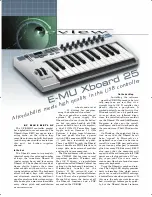
KARMA GE guide
918
2: Random Walk
(“Random Walk Max Step”: 1…9)
Makes available the “Random Walk Max Step”
parameter.
Causes the pitches to meander from the start pitch in a
random fashion, with the largest step that can be taken
in any direction controlled by the “Random Walk Max
Step” parameter. For example, if “Random Walk Max
Step” is set to
2
, then the “pool” of possible choices for
movement from the current Index is
{-2, -1, 1, 2}
. Note
that
{0}
is not allowed as a possible choice. This is good
for creating riffs which sound a bit like improvisation,
especially when you use the Phase Group to ensure
that random phrases will be repeated a number of
times before new ones are chosen.
If you want the possibility of the same notes
happening twice or more in a row, you can use 0:
Pattern, and configure the Index Pattern to have
pools of values including “0,” instead of using
Random or Random Walk.
Random Walk Max Step
[1…9]
Sets the largest step that can be taken when Index
Pattern Type is set to
2: Random Walk
, as described
above. The value relates to movement of the Index
through the Note Series, not a particular musical
interval.
Not available unless Index “Pattern Type” is
2:
Random Walk
.
Random Weighting Parameters
The Random Weighting Parameters are made available
when at least one step in the Index Pattern has
multiple values selected (constituting a “random pool”
of values).
p.911 “Rhythm Group”: “Random Weighting
Pools-Random Factor
[–99…+99]
p.911 “Rhythm Group”: “Pools-Random Factor”.
Pools-Weighting Curve
[0…3]
For more information, see “Rhythm Group” on
page 909, “Pools-Weighting Curve” on page 911, and
“Random Weighting Curves” on page 961.
The following table summarizes the effect of the
various Weighting Curves and the Factor field on the
choices from the Index Pattern Pools:
Associated Parameters
Cluster Mode
[0, 1]
Sets the way that clusters affect the advancement
through the Index Pattern. When set to Multi, a cluster
will advance by as many steps as notes in the cluster,
depending on other internal settings.
0: Single-1 Step per Cluster
Each time a note, cluster of notes, or group of drum
notes is generated one Index Pattern Value will be
chosen for the resulting note or cluster of notes, after
which the Index Pattern advances to the next value.
For example, a cluster of six notes will all be generated
from the next six adjacent notes in the Note Series (or
Drum Pattern) and advance the pattern by one to the
next step. In other words, when a cluster is about to be
generated, the index in the Note Series will first move
an amount determined by the previous Step’s Index
Pattern Value; then all the notes in the cluster will be
generated from adjacent indexes, after which the
Pattern will again advance by one. This is useful for
creating clusters of notes which jump around
following the Index Pattern exactly; the bottom note of
each cluster essentially follows the path that would be
taken by a cluster size of 1, with the effect that cluster
size has no effect on how quickly the Index Pattern
moves through the Note Series and Phase (or Drum
Pattern). Also useful for randomizing Drum Patterns,
since it will cause the index into the Drum Pattern to
jump around and not move forward in a linear fashion.
Index Pattern=
2
, Cluster Size =
6
1: Multi-1 Step For Each Note In Cluster
When the internal GE parameter “Advance Mode” is
0:
Independent
: For every note in a cluster or group of
drum notes generated simultaneously, a separate
Index Pattern Value will be chosen after which the
Index Pattern advances to the next value. For example,
a cluster of six notes will be generated with the next six
Index Pattern Values (with a net advance of six steps).
This means that each note in the cluster will not
necessarily be the adjacent note in the Note Series (or
Drum Pattern), but a certain distance from the
previous note as specified by the pattern value. This is
useful for creating clusters of notes with different
0: Exponential
2: Exp-S
1: Logarithmic
3: Log-S
Index Pool values that receive priority:
Weighting
Curve
Factor
+ (positive)
– (negative)
Exp/Log
higher in grid
lower in grid
Exp-S/Log-S
middle
higher/lower
0: Single
1: Multi
Note
Series:
C2 E2 G2 B2 C3 E3 G3 B3 C4 E4 G4 B4
Step1:
C2 E2 G2 B2 C3 E3
Step2:
G2 B2 C3 E3 G3 B3
Step3:
C3 E3 G3 B3 C4 E4
Step4:
G3 B3 C4 E4 G4 B4
Содержание Electronic Keyboard
Страница 1: ...Parameter Guide Parameter Guide ...
Страница 2: ......
Страница 180: ...Program mode EXi 170 ...
Страница 290: ...EXi STR 1 Plucked String 280 ...
Страница 572: ...Sequencer mode 562 ...
Страница 700: ...Global mode 690 ...
Страница 751: ...Insert Effects IFX1 IFX12 Routing 741 Fig 2 3a Fig 2 3b ...
Страница 902: ...Effect Guide 892 ...
















































